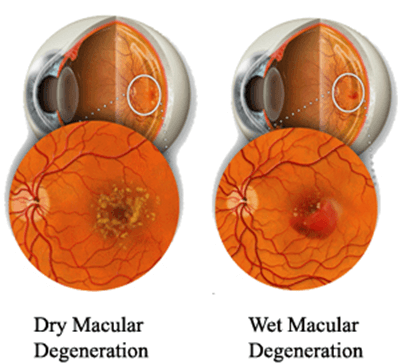What is the full form of ARMDARMD: Age-Related Macular DegenerationARMD stands for Age-Related Macular Degeneration. It is a common eye condition among people over the age of 60, more likely to develop as a person ages. It affects the central part of the retina, called the macula. It gradually deteriorates the macula, which results in blurred or reduced central vision. The macula is responsible for clear vision in your direct line of sight (central vision). So, it causes changes in your central vision and makes everyday tasks difficult. 
Types of AMDAMD is of two types: Dry AMD and Wet AMD Dry AMD: It is the most common type of AMD, characterized by the occurrence of yellow deposits (drusen) in the macula. It progresses slowly, so it causes a gradual change in your central vision. In the advanced stages, it may cause a blank patch or blind spot in the centre of a person's vision. WET AMD: It is a less common form of macular generation which progresses quickly and causes severe changes in a person's central vision in a short period of time, over a few days or weeks. It causes the growth of new abnormal blood vessels from the choroid, a layer underneath the macula. This change is known as choroidal neovascularization. These vessels may leak blood and fluid under the macula, which results in scarring of the macula and thus causes distortion of central vision and may lead to permanent loss of central vision. Risk Factors:
Symptoms:
Its diagnosis involves:
During an eye exam, an ophthalmologist could tell you to glance at an Amsler grid. This grid aids in highlighting any distorted, hazy, or blank areas in your field of vision. An ophthalmologist will also look into your eye using a special lens. He or she can analyze the retina and macula to discover if they have altered. To enlarge your pupil, your ophthalmologist will insert dilating eye drops. They can use a special lens to see into your eye as a result. OCT is another technique for taking close-up pictures of the retina. A device scans the retina and produces incredibly accurate photographs of the macula and retina. Fluorescein angiography may be used by your doctor to examine your retina. Fluorescein, a yellow dye, is injected into a vein, usually in your arm. Your blood vessels are used by the dye to travel. A specialised camera takes pictures of the retina as the dye travels through the blood vessels of the retina. This reveals whether unnatural new blood vessels are developing beneath the retina. How can I lower my chance of developing AMD?According to research, following healthy habits may help you lower your risk of AMD (or slow AMD-related vision loss):
What is the AMD treatment?The stage and kind of AMD affect the course of treatment. Early AMD has no known cure, so your ophthalmologist will likely merely do routine eye exams to monitor your eyes' health. Healthy eating, regular exercise, and giving up smoking can all be beneficial. If you have intermediate AMD in one or both of your eyes, you may be able to avoid late AMD by taking special dietary supplements (vitamins and minerals). These supplements may decrease the progression of AMD in your other eye if you just have late AMD in one eye. Other therapies may be able to stop additional vision loss if you have wet AMD: Anti-VEGF medications that a doctor injects into your eye Injections and laser therapy are used in photodynamic therapy (PDT). There is presently no cure for late dry AMD, but doctors are working hard to find a solution. Additionally, you can seek assistance to help you cope with AMD-related visual loss.
Next TopicFull Form
|
 For Videos Join Our Youtube Channel: Join Now
For Videos Join Our Youtube Channel: Join Now
Feedback
- Send your Feedback to [email protected]
Help Others, Please Share










